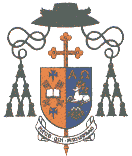PARISH OF TULLYLISH
by Plunkett Campbell
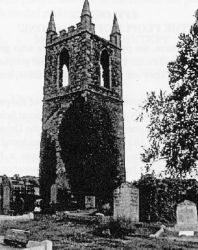
The bell tower of Old Tullylish
Church, the original site of Christian worship in the
area. The surrounding cemetery contains some Catholic
graves.
The present parish of Tullylish, in the Diocese of
Dromore, is situated in the northwest of Co. Down and intersected by the
Upper Bann. For a period prior to the 18th. century, Tullylish and the
ancient and historic parish of Donacloney were joined to Magherally and
Seapatrick to form one single parish which was administered from
Tullylish. This union of parishes lasted until 1851 when the present
parishes of Seapatrick and Tullylish were formed.
ANCIENT ORIGINS
Tullylish Parish, in Irish "Tulach Lis" meaning `the
hill of the fort' or, as stated by Dr. R. Ivens, `the hill of the
enclosure', owes its origin to the siting of an early monastery on an
elevated hill overlooking the River Bann to the east of the present
Church of Ireland in the townland of Tullylish. That a fort, and later a
monastery, should be sited here is understandable since it was a feature
of early Celtic raths and monasteries that they should be situated
convenient to a line of communication and also close to a river. To
state when the monastery at Tullylish was established is not possible
but it may be presumed it was founded in the 6th. or 7th. century.
In the Annals of Ulster we find a record of the
killing of Abbot Dunchu in the year 804 near the shrine of St. Patrick
in `Tulach-Lois' which the author identifies with Tullylish in Iveagh.
If that is so, then the existence here at that period of a shrine of St.
Patrick is of immense interest. The presence of an abbot is a clear
indication that a monastery had been here for some time before the
killing. Dr. Anne Hamlin, a noted authority on early Celtic Monasticism,
states that the killing is the only one of the period ever to be
recorded; unfortunately for us, the reason for such a crime is not
given. However, it seems unlikely that Tullylish was established before
the monastery in Dromore, which was founded by St. Colman about 510 A.D.
The fact that Tullylish monastery was enclosed in a circular fort or
rath-like structure is an indication that it occupied a former Celtic
site which was defensive in nature. Another monastic site in the parish
is found in Donacloney, in the old churchyard, on the banks of the River
Lagan.

In 1152 A.D., at the Synod of Kells, parish
boundaries were established and it was after this synod that the
boundaries of Tullylish and Donacloney would have been defined. Parish
churches were erected to replace the old monastic settlements which were
destroyed by the piratical raids of the Vikings. Research done by the
late Monsignor Christopher Murray shows that in the case of Donacloney,
among the names of clergy associated with the parish in post-Norman and
pre-Reformation times, is to be found an Archdeacon named Andrew who
occupied that office in 1244 and who immediately afterwards became
bishop of the diocese in 1244. While Archdeacon, he was in charge of
Donacloney.
We have to move in time to 1406 before we find
documentary evidence of other priests:
1406-1414: Thomas McStay; 1414: Adam McGinn; 1434:
Patrick McEvoy; 1451-1456: Patrick McStay; 1461-1479: John O'Shiel;
1492: Donat McGinn; 1526-1529; Arthur McGinn.
In the Register of Primate Cromer, under the
date 1526, we read "Tullylish Rec. Tolachlys vacant by the death of
Eugenius Ysuggl (O'Shiel) united to the Archdeaconry of Dromore on
account of the limited income of Archdeaconry". The next Archdeacon to
Eugenius O'Shiel was Arthur McGinn (1526-1529). In the Register of
Primate Dowdall the following are valuations payable to him when he made
his provincial visitations: "Ecclesia de Tullaghlyss - 2 marc; Taxatio
Omnium Beneficiorium, Diocesis Drumorensis Anne - 1.546; Rector de
Tulaglys - 3 marc; Vicarius it idem - 3 marc.' There appears to be no
other documentary reference to the early history of Tullylish Parish.
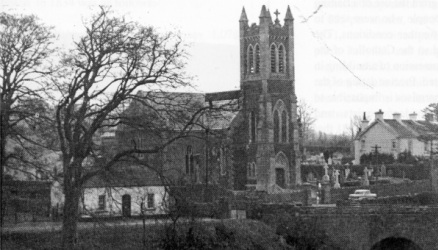
This photograph was taken during repairs
to Laurencetown Church roof, in 1965. Situated in the
townland of Coose, the church has been extended and
renovated several times. The Parochial House, to the right,
was built on land acquired from a Samuel Law in 1849.
POST-REFORMATION AND PENAL ERA
During the upheavals of the 1640s many churches were
sacked and burned. A Cromwellian Inquisition of 1657 reported of the
church at Tullylish that only the original walls remained. It was
rebuilt as a Protestant church in 1698. The church in Donacloney was not
destroyed in the 1641 rebellion although the Protestant clergyman
resident there fled. The Church was eventually destroyed in 1689. In his
Relatio Status, 1675, the Primate reported that there was a parish
priest in each parish of the diocese of Dromore at that time. Curates,
of course, could not be counted in view of the penal enactments then
obtaining. Among priests of the diocese who were outlawed by a
Williamite court held in Banbridge in 1691 was Fr. Edward Magennis from
the parish of Tullylish. In 1704 there were 1,089 registered priests, of
whom 189 were in Ulster. Normally they were not molested by government
officials but in times of political crisis they might have been arrested
on one pretext or another. On 1 1 th. July, 1704 a general session for
registering was held in Downpatrick and there the Rev. Neile Burns, aged
54 years, who resided at Ballyvarley, was registered as "Popish Priest
of Seapatrick, Tullylish and Donacloney." He had been ordained by Daniel
MacKey, R.C. Bishop of Down and Connor. In addition, no one could teach
without a licence. Accordingly, Daniel McCoskran, "a Popist," was
summoned to the Diocesan Court in 1739. This, confirms what is stated in
An abstract of the Returns of the Lord Bishop of Dromore, November 30th.
1731, when His Lordship made his returns to the government, stating that
there was "one Popish school and two priests" in Tullylish Parish. It
may be that the two priests were residing in the parish but that one was
assigned to another parish.
We know from an advertisement in the Belfast
Newsletter dated 6th. March, 1770, that a Fr. Francis Polin ministered
to the Catholics of Tullylish. Indeed it is quite possible that he
celebrated at the Mass Rocks at Holy Mount, Clare, Knocknagore, Bleary
or Ballynagarrick. The advertisement referred to above reads:-
"Any person, who, in three Kalendar months from
the date hereof, lodges in any of His Majesty's Gaols of this
Kingdom, Francis Polin, otherwise McPolin (a Popish Priest of a
profligate and abandoned character) charged before me upon oath with
a Felony of a grievous Nature, shall receive a Reward of Twenty
Pounds to be paid by Rich'd Johnston, Gifford, 3rd. March, 1770."

CHAPELS AT COOSE AND CLARE
The arrival of Dr. Arthur Magennis in the parish
corresponded with the easing of the Penal Laws and the passing of the
first of the Relief Acts. Sometime before 1781, Laurencetown Chapel had
been in existence in Coose. In a survey done in that year by Henry
McClatchy, a chapel, a chapel yard and a paddock are shown. That the
site chosen for the first post-Reformation church should have been in
Coose is by accident rather than by design. The townland of Coose
belonged to the Lawrence family and being a member of an enlightened
family, untainted by the religious bigotry of the period, Henry Lawrence
was persuaded by his daughter to grant the use of a flailing or
threshing house to those people who were seen to worship in the open, in
all weather conditions. The request was duly granted and so the
Catholics of the parish found themselves in possession of a building in
which Mass could be celebrated. Precise dating of the granting of the
use of these premises is impossible to establish. No documentary
evidence exists, and indeed it is quite possible that it was before 1781
that the church came into use. Fr. Hugh O'Kelly succeeded Dr. Arthur
Magennis as Parish Priest of the Union of Tullylish, Donacloney,
Seapatrick and Magherally. At the age of 34, Fr. O'Kelly arrived in
Tullylish to continue the work of his predecessor. He was fortunate to
befriend the landlords of the area and this enabled him, when the
political climate was ripe, to negotiate a lease of the chapel and
ground in the townland of Coose.
Laurencetown Chapel was not the only edifice used by
the parishioners. Although no lease survives, records show that a Mass
I-louse existed in Clare from the second half of the eighteenth century.
Perhaps it was part of the original land of the Magennis Clan who had a
strong fortification in the townland, and it is reasonable to assume
that sacred worship would continue in an established `house'. However,
this was not to survive the ravages of the next wave of sectarian
violence.
19th. CENTURY - TOLERANCE AND
PROGRESS
Life became more tolerable for Catholics in the early
19th. century and some of the restrictions imposed were removed. Fr.
O'Kelly availed himself of the opportunity of having a chapel built in
Clare on the site of the original Mass House which had earlier been
destroyed during a sectarian attack. In 1801, while Vicar General of the
Diocese, Fr. Hugh O'Kelly declined the bishopric but became Dean of
Dromore, after Dr. Edmund Derry had become bishop. On 29th. October
1819, Dr. Derry died and, on the 30th. January 1820, Fr. O'Kelly was
appointed bishop to succeed him. From the peaceful environment of
Hallsmill he travelled to Newry to take up residence in Boat Street,
which at the time was the bishop's residence. His successor in Tullylish
was Fr. Edmund Magennis, a native of Tullylish Parish, reputedly a
relative of Dr. O'Kelly.
Dr. O'Kelly's zeal and determination to extend church
buildings continued after his appointment in Newry. He is known as the
founder of Newry Cathedral. He completed negotiations for the
acquisition of land for the Cathedral and obtained legal permission for
the work to commence.

EDUCATION IN 19th. CENTURY
TULLYLISH
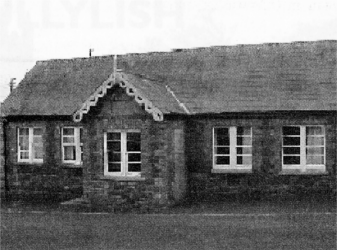
Castle Hill
National School (1879), in the grounds of St. John's Church,
Gilford. It continued to provide education until the new St.
John's Primary School was opened nearby, in 1957.
When Fr. Edmund Magennis was appointed to succeed Dr.
O'Kelly, circumstances were generally improving in the parish. It was
the eve of Catholic Emancipation when, for the first time in centuries,
Catholics could maintain schools, join professions and, if they met the
qualifications, vote at parliamentary elections. Faced with the problem
of an increasing population both in Tullylish and in the developing town
of Banbridge, where no Catholic church existed, Fr. Magennis had a
formidable task ahead of him. In addition, there was an attempt by
government to organise a system of education embracing all creeds.
Though the outcome was unsuccessful, it did involve Fr. Magennis in a
school-building programme. Existing schools were located at Knocknagore,
Bleary, Ballynagarrick, Moyallon, Gilford, Coose, Ballydugan, Kernan and
Ballymacanallan. Only four of these schools had Catholic masters.
Moyallon was run in conjunction with the Society of Friends where
Francis Campbell was paid �27.7.6 per annum. At Gilford the master was
Arthur Geoghegan and he was paid �19.10 per annum. His school was
located on Whinney Hill. The school in Coose was run by Edward Geoghegan
whose salary was �20 per annum. Hugh Burns organised the only Catholic
`hedge school' in the parish.
The church at Coose, Laurencetown was extended and
completed in 1834. It now accommodated 750 people. Its average
attendance was 600 and the total cost of completion - �150 - was raised
by subscription. The Catholic population of the `parish union' in 1834
was as follows:-
| Tullylish 3,205 |
Donacloney 1,078 |
| Seapatrick 1,424 |
Magherally, 309 |
These make a grand total of 6,016. Tullylish and
Donacloney, with a combined population of 4,629, were served rather
inadequately by only two chapels while Seapatrick and Magherally, with a
population of 1,733, had no church or chapel at all.

In 1834, Fr. Edmund Magennis set about the task of
building a chapel in Banbridge. He would have been encouraged, it not
entirely influenced, by Most Rev. Dr. Blake who had become Bishop of
Dromore in 1833. Financial difficulties disrupted the project and it was
temporarily abandoned in 1834 as the Ordnance. Survey Memoirs stated:
"A Roman Catholic
Chapel at present building at the North end of Dromore St. is a
whinstone building; the front of which is corniced and buttressed
with granite. The windows and doorways are Gothic, the arches of
which are brick. The building is rectangular, 80 feet by 40 feet. It
has already cost �450, which sum was raised by public subscription.
The work is at present at a stop for want of funds; when completed,
the accommodation will be for 1,000 persons".
A dispute arose which caused the bishop to appoint a
committee to run the affairs of the parish. Fr. Magennis was removed
from his position of Parish Priest. The chapel was still incomplete in
1837 with correspondence of the time stating that money spent to date
amounted to �450. However, the chapel was eventually completed and on
21st. June 1841 it was solemnly opened and dedicated to St. Patrick by
Dr. Blake. The special preacher on the occasion was Father Theobald
Mathew, the famous apostle of Temperance in Ireland.
So ended an era in the history of Tullylish.
Steadfastness and zeal had been the hallmarks of its illustrious
history. However, as the combined parishes of Tullylish, Donacloney,
Seapatrick and Magherally were about to be divided into their respective
parishes of Tullylish and Seapatrick, memories still lingered of the
sorry episodes that had temporarily disunited the parishioners, bishop
and the parish priest of the time, Fr. Magennis. No evidence survives as
to what the problem really was but it was eventually `resolved' rather
unamicably by appointing quasi - administrators such as Fr. John Doran
in 1836 and Fr. Mooney in 1841 who, incidentally, was the first
Catholic Chaplain of Banbridge Workhouse at a salary
of �25 per annum, and Fr. John Byrne in 1844. So, in 1851, the combined
parish was subdivided and in its place Tullylish and Seapatrick became
separate and distinct, with Laurencetown and Banbridge as their
respective administrative centres. Fr. Magennis had been `exiled' to his
farm in Knocknagore and took no further part in the administrative
affairs of the parish.
A CHURCH FOR GILFORD AND NEW
PAROCHIAL HOUSE FOR LAURENCETOWN
Fr. John Byrne was now in charge of the parish of
Tullylish having become Parish Priest in 1849 after the death of Fr.
Edmund Magennis.
In 1849 a site for a Parochial House was purchased
beside the church in Laurencetown. The land was obtained from Samuel
Law. The new presbytery was to replace the house previously occupied by
the priests in Knocknagore, locally known as "The Priest's Hill."
However, the most important acquisition of land was that portion
containing 2 roods and 23 perches on Castle Hill which was to provide
sites for a church and national school. This land was donated by Mr.
Hugh Dunbar, mill owner. Originally the church was designed to
accommodate a priest above the sacristy at the rear of the building.
There is no evidence to suggest that a priest did take up residence
there and it must be presumed that priests who served the entire parish
lived at Laurencetown, Hallsmill or, later, at Drumhorc.
St. Colman's Church, Laurencetown, was further
reconstructed in 1869-70 and on its completion in 1870 it was dedicated
by Most Rev. Dr. Leahy, with Fr. Tom Burke O.P. as the preacher. No
evidence survives as to the extent of the reconstruction but it appears
it was mostly confined to internal work for, as we shall see later, Dr.
Leahy was concerned about the potential danger of the roof of the
building, as stated in a letter to Fr. O'Hagan. On 6th. June 1877, Fr.
John Byrne P.P., died after labouring in Tullylish for 33 years. He is
interred in Laurencetown cemetery.

BELFRIES FOR GILFORD AND
LAURENCETOWN
In 1877, Rev. Bernard O'Hagan, Adm. Newry, was
appointed Parish Priest in succession to the Rev. John Byrne. On leaving
Newry he was extolled by his former parishioners as being an eloquent
priest, a patriot and a private friend of everyone. Bishop Leahy
requested Fr. O'Hagan to visit America on lecture
tours to secure funding for the purpose of repairing
the church in Laurencetown and building a new school in Gilford. Canon
O'Hagan wasted little time in preparing for his visit to the U.S.A. On
19th. October 1878 he sailed on R.M.S. Bothia for New York. He spent
several years there lecturing on a wide range of topics that were of
interest to his Irish American audience. Only a man of gifted talent,
academic excellence and literary genius could offer such a range of
topics to include:
|
`John Mitchel and His Times'. |
|
`St. Patrick's Mission - Its Labors and
Fruits'. |
|
`The Irish Brigade of a Hundred Years
Ago'. |
|
'Catholic Church of Ireland versus The
Penal Laws'. |
|
`Ireland's Hopes and Fears for 1880'. |
|
`Ancient Liturgies of the Mass'. |
|
`Ireland and its Course in the Present
Crisis'. |
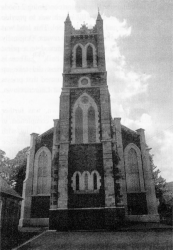
St.
John's Church, Castle Hill, Gilford was built on
land donated by local mill owner, Hugh Dunbar.
The original church in Gilford had no tower or
belfry. Ever mindful of this, Mr. Patrick Reilly, a former parishioner
and by now a successful merchant in Baltimore, U.S.A., presented the
bell as a gift to the parish of his forefathers. It helps to illustrate
most forcibly the intimate association of kinship between Ireland and
the U.S.A., and to understand how close the ties are that bound Irishmen
together in the sacred cause of religion. On 2nd. June 1889, His
Lordship Most Rev. Dr. McGivern, Co-adjutor Bishop of Dromore, performed
the ceremony of the blessing of the bell.
Canon O'Hagan was also responsible for building an extension to Bann
National School, Laurencetown, as h well as extending the Parochial
House in 1873 and building a belfry at the rear of St. Colman's Church,
Laurencetown. The bell was forged in Dublin in 1877 and, although no
information relating to the erection of a tower survives, it is
generally believed to have been built between 1877 and 1889. It must
have come as a shock to parishioners and relatives alike to learn that
Canon O'Hagan died suddenly while on holiday in Rostrevor on 10th.
August 1895, aged 68 years.
On 13th. August 1895, Fr. Bernard MacAleenan was
appointed P.P. Tullylish. He was quite familiar with the parish; from
1883-87 he had been a curate in Tullylish and he had been curate in the
neighbouring parish of Seapatrick for eight years prior to his
appointment as P.P. His pastoral reign was short for, on 22nd. December
1897, he died and was interred in Laurencetown. He is best known for his
generosity in donating to Dr. McGivern, Bishop of Dromore, the cash
necessary to purchase the peal of bells for the Cathedral tower in
Newry.

BIRTH OF GILFORD CATHOLIC CLUB
On January 21st. 1898, the Parish Priest of Aghaderg,
Fr. Peter Paul Campbell, was appointed RR Tullylish. He was to steer the
parish from the Victorian into the Edwardian age. Many stories are told
of his phobia at the sight of the coppers in any collection. He took
steps to have these removed from circulation in order to reduce the
possibility of them finding their way into subsequent collections!
In 1898 to organise and provide a social centre in
Gilford, a committee consisting of James Byrne, Daniel McConville,
Joseph Monaghan, Hugh Turley and Wm. Lappin was formed. They rented a
house in the vicinity of the entrance to St. John's Primary School and
named it the 'Gilford Catholic Club.' Over the next few years membership
increased rapidly and, to cater for this increase, the committee -
Daniel McConville, James Byrne, Joseph Monaghan, Patrick Delaney, John
McGuigan, John Kavanagh and Edward Murphy purchased two houses from Mr.
W.H. Boyle on Castle Hill. These premises, suitably converted, catered
for the social needs of the people of Gilford.
Fr. Campbell died on 14th. July 1911 and is interred with his
relatives in St. Mary's Cemetery, Newry.
NEW TOWER FOR LAURENCETOWN
CHURCH
On 8th. November 1911 Dr. Michael McConville was
appointed P.P. Tullylish. A native of Drumlough in the parish of
Drumgath he was educated at Propaganda College, Rome, where he took a
doctorate in Divinity and Philosophy. Because of his huge stature and
erudition he was known as `The Big Doctor'. According to Padraig
Keenan's Clergy of Dromore Diocese, Dr. McConville entered Mount
Mellary Abbey, Co. Tipperary, for eighteen months before resuming his
pastoral duties in Lower Drumgooland.
Dr. McConville saw the urgent need for a new tower
and belfry in Laurencetown. On his appointment he set about raising the
necessary fund of �2,000 for the project. No report of the opening and
dedication of the tower is to be found in any newspaper and so it is
left to those who remember the occasion to describe it as best they can.
It appears to have been dedicated unofficially in 1912, the occasion
being commemorated by a re-sited plaque which reads as follows:-
Of your charity
Pray for the Happy Repose of the Soul
of Very Rev. Michael McConville D.D. D.Ph.P.P.
who erected this tower.
A.D. 1912
Little was recorded by Dr. McConville regarding
parish affairs during his brief pastorate. He died on 12th. December
1913 - only two years after his appointment. However, it was later
discovered that he had paid for the erection of the tower out of his
personal estate. He also is interred in Laurencetown Cemetery.

NEW ALTAR AND PAROCHIAL HOUSE FOR
GILFORD
On 6th. January 1914 Fr. Joseph Doyle, a native of
Dromara, was appointed P.P. He had been Administrator in Newry prior to
his arrival in Tullylish. Despite the difficulties of the First World
War, and the sectarian strife in the local mills and bleach greens in
the period 1918-1920 when many
parishioners were turned out of their work, Fr. Doyle
managed the affairs of the parish with determination and resolve.
Accommodation for the clergy was minimal and visiting and relief priests
had to use `lodgings' in the village. Consequently he extended the
present house in Laurencetown in 1923 and purchased a house in The
Square, Gilford on 14th. December 1926. Fr. M. Brown C.C. became the
first resident curate in Gilford in the parochial house. Previous
curates had used rooms at 19 Mill Street.
In February 1930, an ornate altar was purchased from
Clonallon Parish and installed in Gilford Church. This replaced the
altar which had been in use since the opening of the church in 1849. In
order to help defray the costs of an internal reconstruction Mr. John
Gough, Gilford, donated the doors of the church and Mrs. Byrne and her
sister Mrs. O'Sullivan donated the Stations of the Cross which continue
to adorn the walls of the church. In 1932, a new set of Stations of the
Cross were purchased for Clare.
Parishioners still recall the sadness and
bewilderment felt in the parish when, on Sunday 8th. June 1935, the
tolling bell informed the people that their beloved pastor had died
rather suddenly. He had suffered a fatal fall in the Parochial House in
Banbridge and is interred in Laurencetown cemetery. On 4th. July 1935,
Canon Carr was transferred from Annaclone to Tullylish as R.P. in
succession to Canon Doyle. He was considered one of the most eminent
priests in the diocese. Padraig Keenan recalls that he was beloved alike
by the clergy and laity for his unaffected simplicity and unfailing good
humour. On the 20th. March 1936, he died, much to the sorrow and regret
of those who had so little time to make his acquaintance. Like the
majority of his predecessors, he was buried in Laurencetown.
LAURENCETOWN YOUTH CLUB
When Fr. Henry Doran, later to become Canon, arrived
in Tullylish on 31st. March 1936, the parishioners must have felt
legitimate pride in their achievements, in having three well-maintained
churches and two parochial houses recently renovated to an acceptably
high standard.
Fr. Albert McGovern was appointed curate in
Laurencetown in July 1946. He readily accepted the challenge to provide
the necessary accommodation for a parish youth club. Fr. McGovern
purchased two U.S. army nissan huts for �180, had them erected by
voluntary labour and so St. John Bosco Youth Club was opened in 1947.
For 38 years it served the needs of two generations.
On 6th. November 1948 the tolling bell informed the
parishioners that their beloved priest, Canon Doran, had died suddenly
during the night. The sadness evoked by his unexpected death was keenly
felt by his parishioners.

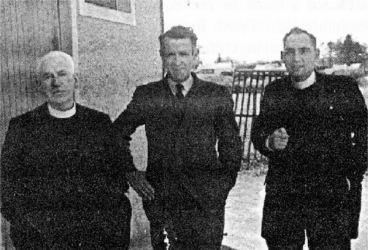
The late Frs. J.J.
Lennon (left) and Albert McGovern (right), pictured with Mr.
Paddy McEvoy outside the St. John Bosco Youth Club at
Laurencetown in the early 1950s. The Youth Club was opened in
1947.
ADVANCES IN SCHOOLING AND A
NEW
HALL IN GILFORD
Fr. John Joseph Lennon, a native of Rathfriland, was
appointed Parish Priest on 6th. December, 1948. No stranger to the
parish - he had been a curate there in 1916-17 - he soon renewed old
acquaintances. He always spoke briefly and very much to the point. A
life-long interest in the language and culture of Ireland coloured his
whole outlook.
In Tullylish, a new primary school was planned for
Gilford and an extension to Bann Primary School in Laurencetown. In
addition, the parish had to contribute its share to the provision of new
secondary schools in Banbridge and Lurgan. In 1955, a site was purchased
for �500 for the new school in Gilford and, once planning approval was
granted, work commenced immediately. The foundation stone was laid on
16th. August 1956 by Most Rev. Eugene O'Doherty, Bishop of Dromore. On
that occasion he visited and inspected the progress being made in
building the new Catholic Club hall. 1957 was a momentous year in the
history of the parish. On Sunday, 20th. January, Bishop O'Doherty
officially opened the new hall. The new building - 85 feet by 38.5 feet,
with spring flooring - compared favourably with the best halls of the
day. In September, St. John's Primary School, Gilford was officially
blessed and opened by the bishop, the total cost being �20,000. In the
autumn of 1957, work was completed on an extension to Bann Primary
School, Laurencetown. A new classroom, staffroom and meals' servery were
completed at a cost of �11,000. This work was carried out by McConville
Bros., Building Contractors, Portadown. Schools in the parish were now
of modern design and comparable to any to be found in any sector of the
educational system.
Fr. Lennon, along with his parishioners, had achieved
his ambition and provided the necessary facilities that he had spoken of
so often during his early ministry in the parish. He died on 19th.
November 1958 and is interred in Laurencetown cemetery.
VATICAN II AND RENOVATION AT
GILFORD, LAURENCETOWN AND CLARE
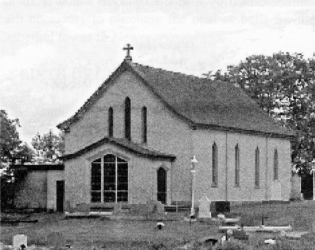
St. Colman's
Church, Clare. A `Mass House' probably existed here from the
later eighteenth century. The present church was extensively
renovated 1966-67.
On 19th. March 1959, Very Rev. Canon Thomas Pettit, a
former President of St. Colman's College, Newry, was appointed P.P.,
Tullylish. A quiet unassuming gentleman, he undertook beautiful and
artistic renovations of Laurencetown and Clare churches. He was assisted
by a dedicated and enthusiastic committee. Meanwhile, in 1962, a
committee under the guidance of the late Fr. Christopher Murray
undertook a refurbishment of Gilford Church, on a voluntary basis. A new
floor and a reconstructed gallery and stairway were completed. On Sunday
30th. January 1966, the Church of Saints Colman and Patrick,
Laurencetown was rededicated and reopened by Most Rev. Dr. O'Doherty.
The celebrant of the Mass was Rev. A. Byrne, St. Colman's College,
Newry; deacon, Rev. M. O'Rourke, C.C., Derrytrasna; subdeacon, Rev. L.
McAleavey, C.C., Lurgan and Master of Ceremonies, Rev. J. Lynch, Adm.,
Newry. The special sermon on this occasion was preached by Rev. C.F.
Murray, C.C., Gilford. The reopening of the church followed extensive
renovations including a raised roof, projecting confessionals and
baptistry at west and east transepts respectively, a new sanctuary,
sacristy, gallery and committee rooms to the rear. The redesigned altar
conformed to the new liturgical requirements of Vatican II. The
contractor for this project was Messrs. Chas. Monaghan, Ltd.,
Laurencetown. The completed reconstruction cost was �40,000. On Saturday
6th. May, 1967, St. Colman's Church, Clare, was reopened by Dr.
O'Doherty. It had undergone extensive renovations costing �15,000.
Due to deteriorating health, Canon Pettit resigned
his parish on 25th. January 1970 and, from that date, was a patient in
the St. John of God Nursing Home, Newry. He died on 21st. February 1975
and was buried in Laurencetown.

Fr. John M. Lynch was appointed Parish Priest on 9th.
February 1970. Prior to his appointment to Tullylish, Fr. Lynch, who was
a native of Rathfriland, had been Administrator in Newry. He was
interested in the promotion of Gaelic games and it is in this area that
he will be remembered by the parishioners. During his eight years in the
parish, he worked towards the improvement of playing facilities. His
first purchase was approximately twelve acres of land in Knocknagore.
This acquisition had been, for a very long time, the objective of the
local football team. However Fr. Lynch, realising this, planned and
developed a first-class playing pitch and leased it to Tullylish G.F.C.
free of charge. He also entered into negotiations with the Department of
Education (N.I.) for a replacement primary school in Laurencetown.
During the 1970s, Fr. Lynch had to comfort and give
spiritual support to those many bereaved families in the parish who had
suffered so tragically from sectarian and political strife.
On 25th. April 1978, the Parish Priest died rather
suddenly. Only after a post mortem was it discovered that Fr. Lynch had
been a very sick man, though he had concealed his true state of health
from even his closest associates. He was buried in Laurencetown
Cemetery.

SCOUTING FACILITIES AND A NEW
BANN
SCHOOL
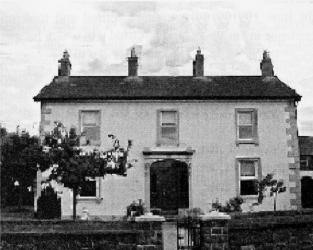
Laurencetown Parochial House overlooks the River
Bann and the modern village.
On 26th. May 1978, Fr. John Treanor M.A. Dip.Ed.,
Parish Priest of Magheralin, became P.P. Tullylish. Deeply interested in
Gaelic Football, Fr. Treanor was soon aware of the needs of the local
club.
Past glories blended with the present when Fr.
Treanor arranged for the complete renovation of out-offices of the
Parochial House, Laurencetown, which had been derelict for years. With
voluntary labour they were tastefully renovated and decorated. On 28th.
June 1982, the Bishop of Dromore, Dr. Brooks, blessed and officially
opened them as a scout den for St. John's l 1th. Dromore, Tullylish
C.B.S.I. (Catholic Boy Scouts of Ireland). The following spring, Castle
Hill disused National School in Gilford was extensively renovated, at a
cost of �6,000. It became the Parish Hall and also a den for the St.
Martin's Catholic Girl Guides which had been formed on 13th. March,
1983.
Through the work of an enthusiastic committee, the
cemeteries at Clare and Laurencetown were redesigned, with pathways laid
throughout and groundwork re-arranged to afford easy maintenance. Much
of the manual work was done by Fr. Treanor himself who, by his keenness
and example, encouraged able-bodied parishioners to give a helping hand.
He preserved property that would otherwise have remained unsightly
through neglect and decay. With his committee, Fr. Treanor completed the
long and protracted negotiations with the Department of Education and
the contract for the building of the new Bann School was awarded to A. &
M. Builders, Toomebridge for the tendered sum of �262,000. Fr. Treanor
also arranged the transfer of the Gaelic Football field to the local
Tullylish G.F.C. This park was officially opened on 13th. May 2001 by
Mr. Liam Mulvihill.
In June 1998, Canon Treanor retired and took up
residence in Warrenpoint. The esteem in which he was held was reflected
in the many tangible tributes paid to him on his departure.

21st. CENTURY AND BEYOND ....
Fr. Desmond Knowles, straight from the Irish College
in Paris, arrived in the parish in the summer of 1998. His easy manner
and his interest in the liturgy and church decorations won him many
friends throughout Tullylish. Supported by an active and enthusiastic
group of parishioners, Fr. Knowles set about surveying church property.
The report on the roof of St. John's Church, Gilford confirmed their
worst fears - a new roof was required, together with the necessary
ancillary work. Currently they are attempting to access cash from the
'Heritage Fund' to help defray some of the �0.5 m contract price.
Unfortunately Fr. Knowles left Laurencetown in
September 2002, for one year, to oversee the setting up of an Irish
Chaplaincy in Paris. He was temporarily replaced in Laurencetown by Fr.
Martin McAlinden. In his absence, the parish was ably administered by
Fr. Paddy Joe Murray, C.C. Gilford. In August 2003, Fr. Knowles returned
to Tullylish and was appointed a Canon of the Cathedral Chapter. Fr.
Murray became Parish Priest of Aghaderg and Fr. McA linden moved to
Banbridge. Meanwhile, Fr. Arthur MacNeill, previously Parish Priest of
Magheralin, was appointed as curate to Gilford.
So, in the 21st. century, Tullylish awaits whatever
the future may hold. In this brief history of Tullylish only prominent
clerics have found a mention and this, perhaps, has distorted the image
of the past which it presents. Many parishioners have, by their devotion
and hard work, contributed generously in time, effort and finance to the
development of their historic parish. This is not the final stage of its
history but merely an interlude. The Catholic population of about 2,250
must face a world controlled by the triumphs of science and technology.
This account of Tullylish over the centuries gives
hope that the values handed down by past generations will be cherished
and maintained in the future.
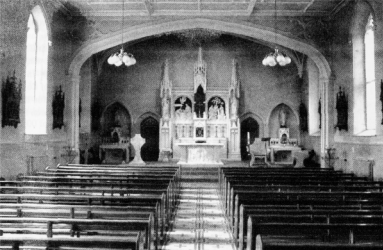
The interior of St. John's
Church, Gilford, as it is today.
 |
